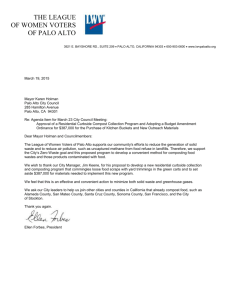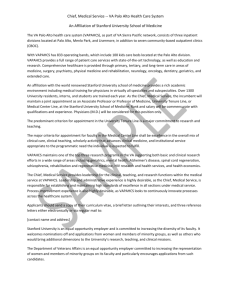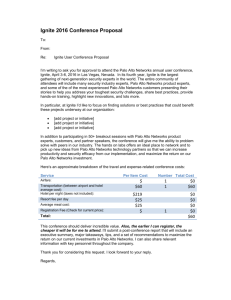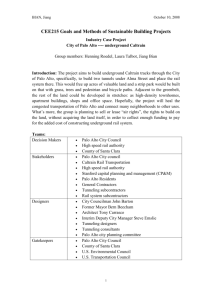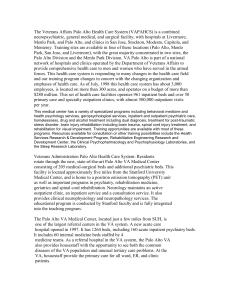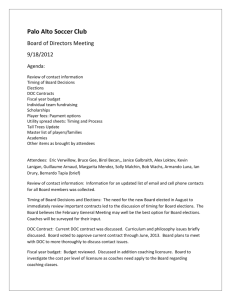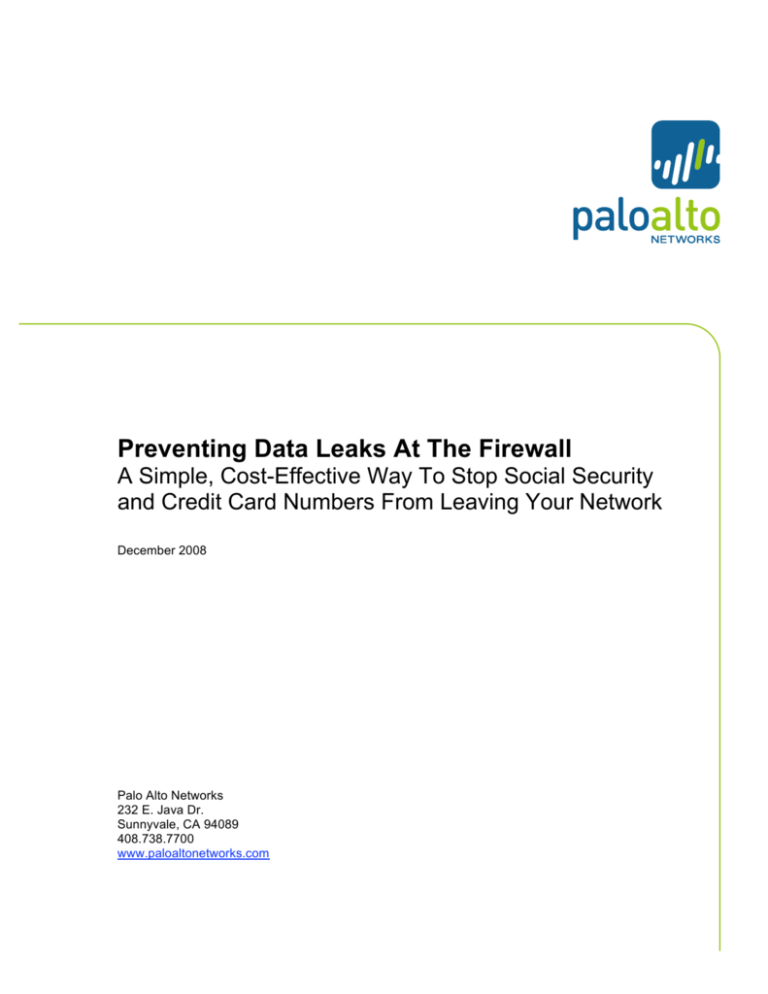
Preventing Data Leaks At The Firewall
A Simple, Cost-Effective Way To Stop Social Security
and Credit Card Numbers From Leaving Your Network
December 2008
Palo Alto Networks
232 E. Java Dr.
Sunnyvale, CA 94089
408.738.7700
www.paloaltonetworks.com
Table of Contents
Executive Summary ...........................................................................................................................3
Data Leakage Continues to Be a Problem For Enterprises ...............................................................4
DLP Technology is Cumbersome, Incomplete, and For Many, Overkill…And Don’t Forget
Expensive...........................................................................................................................................4
For 90% of Enterprises, Keeping Social Security and Credit Card Numbers From Leaking Would
Be Enough .........................................................................................................................................4
The Perimeter Is Key, But Legacy Security Technology Can’t Help ..................................................4
First - Block “Bad” Applications ......................................................................................................5
Second - Scan “Good” Applications. Including SSL. .....................................................................5
Lastly - Know Users, not just IP addresses ....................................................................................5
A Word on Performance .................................................................................................................5
TM
Palo Alto Networks Is First to Include DLP Functionality In The Firewall .......................................6
It’s Time To Fix The Firewall ..............................................................................................................9
© 2008 Palo Alto Networks
Page 2
Executive Summary
Numerous examples of accidental and deliberate data leakage continue to make headlines,
and data leak prevention (DLP) technologies are being touted as a panacea. Unfortunately,
given the scope, size, and distributed nature of most enterprise datasets, just discovering
where the data is and who owns it is a challenge, and many DLP projects are proving slow
to progress. Furthermore, given the absence of control over applications in most enterprises,
it isn’t clear that DLP technologies would have helped in several of the recent cases (US
Army, Pfizer, etc.). Some organizations, for business model or cultural reasons, will have to
go through the effort of large-scale DLP implementations. For most organizations, however,
controlling the applications most often used to leak sensitive data and stopping unauthorized
transmission of credit card and social security numbers and their ilk would be acceptable.
Exerting that control at trust boundaries is ideal – whether the demarcation point is between
inside and outside or internal users and internal resources in the datacenter – the firewall
sits on the perfect spot, seeing all traffic. Unfortunately, legacy port- and protocol-based
firewalls can’t do anything about any of this – being ignorant of applications, users and
content. To do this correctly, enterprises should first achieve a degree of control over
applications – thus limiting the avenues of data leakage. Second, organizations need to
scan the applications they do want on their networks, for confidential data. Third,
organizations should be able to understand which users are initiating these application
transactions.
TM
Palo Alto Networks next-generation firewalls incorporate three key technologies that
enable enterprise customers to incorporate some of the most commonly needed DLP
functionality at their network perimeter – easily, and without adding more appliances. AppTM
ID , User-ID, and Content-ID, coupled with the high-performance, multi-gigabit next
generation firewall platform offers immediate relief to the most common data leakage pain
(SSN/CC moving over unauthorized applications), allowing enterprises to complete their
large scale DLP projects at their leisure.
© 2008 Palo Alto Networks
Page 3
Data Leakage Continues to Be a Problem For Enterprises
Large scale, public exposures of personal information remain far too common. Practically
weekly, headlines declare tens of thousands of credit card numbers leaking out of retailers,
or social security numbers leaking out of government agencies, health care organizations, or
employers. A recent example (December, 2008) showed a misconfigured and prohibited
peer-to-peer file sharing application putting a database of 24,000 US Army soldiers’ personal
information in the public domain. This is similar to the Walter Reed Medical Center breach in
June 2008, or the Pfizer incident from 2007 – all three involved data leaking through the
perimeter via an application expressly prohibited by policy.
DLP Technology is Cumbersome, Incomplete, and For Many,
Overkill…And Don’t Forget Expensive
Data leak prevention (DLP) technology has captured the attention of many IT organizations,
with a promise to help organizations manage their confidential data. Project scope, for these
technology providers, however, is a problem. Questions of access control, reporting, data
classification, data at-rest vs. data in-transit, data ownership, desktop agents, server agents,
and encryption have slowed DLP projects to a crawl in many organizations. Venture
capitalists funded many data leakage prevention vendors, many of which have been
acquired by larger security companies, who have further expanded the scope of an already
unwieldy offering. Some of these vendors are now marketing data loss prevention, which
incorporates practically the entire information security function (and even includes elements
of storage management!). Needless to say, this broadened scope is beneficial, but adds
complexity, time, and expense – both in hard costs and in staff time. Oddly enough, many of
the recent breaches caused by unauthorized and misconfigured peer-to-peer file sharing
applications wouldn’t have been prevented by the typical implementation of DLP
technologies on the market today – because control of applications isn’t addressed.
For 90% of Enterprises, Keeping Social Security and Credit Card
Numbers From Leaking Would Be Enough
For a few highly intellectual property-dependent organizations, implementing a long-term,
comprehensive DLP project – which should ultimately include data discovery, classification,
and cataloging – is appropriate. But for the remaining 90% of enterprises out there, stopping
a couple classes of confidential data (e.g., social security numbers and credit card numbers)
at the trust boundary would be a great start. This would avoid the expensive and
embarrassing public exposure of employee and/or customer personal data.
The Perimeter Is Key, But Legacy Security Technology Can’t Help
If enterprises could control the flow of confidential data at the trust boundary, it would stop a
large percentage of incidents that regularly make the news. Unfortunately, the legacy
security infrastructure at most enterprise perimeters is poorly equipped to offer this
functionality. Most firewalls sit in a great position to help – they demarcate the trust
boundary, they see all traffic, and they exert policy control (i.e., they can block traffic). But
legacy firewalls don’t understand content, don’t understand applications, can’t see inside
SSL-encrypted traffic, and have no understanding of users. In fact, if it isn’t source or
destination IP address, source or destination port, or network protocol, firewalls don’t
understand it. Other firewall “helpers” (e.g., intrusion prevention systems, web proxies, URL
filtering devices) only see a portion of the traffic, don’t sit in-line, and/or have limited
application and content understanding.
© 2008 Palo Alto Networks
Page 4
First - Block “Bad” Applications
Examining most of the recent incidents, the first thing enterprises need to do is get control
over which applications are running on the network. Every organization has a different view
of desirable and undesirable applications. Each enterprise needs to look at applications
from both benefit and risk perspectives. On the benefit side, an application might help an
employee do their job better, faster, or cheaper, or improve customer relations, or make the
workplace more pleasant. On the risk side, applications may harbor vulnerabilities, carry
malware, be prone to misuse, or – particularly relevant to this discussion – transfer files. In
some cases, organizations want to enable social networking applications for cultural reasons,
or for business reasons – or block them for security reasons. Either way, the first thing to do
with regard to stopping confidential data leakage is to identify which applications are moving
across the network – regardless of whatever evasive tactic the application employs, and
block undesirable applications (thus limiting the avenues through which confidential data can
flow). In order to do perform this control effectively, the device needs to “see” all traffic.
Second - Scan “Good” Applications. Including SSL.
The second thing to do is scan desirable applications for confidential data leakage. Once an
organization has settled on the applications it wants on its network, the next step is to scan
applications for confidential data leakage – including SSL-encrypted application traffic and
compressed content. As an aside, any applications that use proprietary encryption (e.g.,
Skype) should be very closely evaluated, because if allowed, they cannot be scanned.
Generally, this content scanning should be high performance (high throughput, low latency),
unobtrusive, and easily implemented. More specifically, the scanning capability should be
simple to enact in policy, and adjustable in sensitivity, to allow normal appropriate
transactions without triggering response – yet still detect abnormalities.
Lastly - Know Users, not just IP addresses
The third thing to do is to bring users into the picture. Understanding which users are using
applications, and which are engaged in moving particular classes of content has two benefits
– actionable visibility, and refined policy. The most efficient way to do this is to tie into the
enterprise directory (identities and groups are already there). Often, when an organization
hears that they’ve had a leak, the first thing they ask is, “who leaked it?” Having the ability to
understand users – not just IP addresses – gives the granularity enterprises need to guide
specific users about policy, and take more serious action if warranted. The second benefit
understanding users offers is the ability to incorporate that understanding into policy – so
certain users might be enabled to use certain classes of applications, and other users might
not. This empowers enterprises to further compartmentalize and contain risk.
A Word on Performance
Today’s applications are real time in nature. With the exception of email, for which delays go
largely unnoticed, users expect instant response from their applications. Which means that
the network that those applications run on cannot delay applications and content. The
reason for highlighting this is simple – any solution that meets the above three requirements
must be high performance in nature – high throughput, low latency – both in scanning, as
mentioned above, but also in traffic processing.
In summary – if IT staffs know the application, the user, and the content (i.e., whether or not
the traffic contains confidential information), they can act – block or alert – quickly, and
appropriately, without sifting through dozens of log files.
© 2008 Palo Alto Networks
Page 5
Palo Alto NetworksTM Is First to Include DLP Functionality In The
Firewall
Palo Alto Networks offers enterprises a unique approach – visibility and control over
applications, the ability to scan application content, and visibility and control of users and
groups. Palo Alto Networks next generation firewalls incorporate 3 key identification
technologies into a high-performance platform. App-ID, Content-ID, and User-ID give
organizations business-relevant control over applications.
TM
App-ID Classifies Applications. App-ID technology identifies applications regardless of
port, protocol, encryption, or evasive tactic. App-ID currently recognizes over 750
applications, and Palo Alto Networks adds 3-5 new applications per week – giving
enterprises visibility and policy control over actual applications, not just ports.
Content-ID Identifies Content – Including Confidential Content. Content-ID technology
incorporates 3 key content security elements – confidential data (DLP functionality), threat
prevention, and a URL filtering capability. Content-ID is stream-based scanning engine
using a unified signature format. Which means, first, that it doesn’t buffer files, and second,
that it only scans once, for all content security functions. Palo Alto Networks’ single pass
architecture is discussed further below. The data filtering feature in PAN-OS makes
implementing DLP functionality in the firewall simple. As shown in Figure 1, adding a policy
object that scans application traffic is a matter of assigning the data filtering profile to the
policy, determining what sort of data to scan for, and assigning a weight (i.e., number of
occurrences that trigger the policy action). For example, for one application, Yahoo Instant
Messenger, an organization could say that a single credit card number would trigger a policy
action (‘block’), but another class of application, say, Social Networking, a user would need
to transmit 3 credit card numbers to trigger the policy.
Note that the SSN and credit card signatures use validation algorithms to minimize false
positives (e.g., Luhn algorithm for credit cards). Enterprises can also use the regular
expression capability built into the data filtering feature to create custom patterns.
Figure 1 - Adding a Data Filtering Policy Object
© 2008 Palo Alto Networks
Page 6
User-ID Integrates With Enterprise Directories. User-ID technology integrates Palo Alto
Networks’ next-generation firewalls with enterprises’ Active Directory implementations.
Meaning that the single policy engine governing application and content security also has
the ability to refine that policy with the user and group definitions already used in the
enterprise.
High Performance Platform. Palo Alto Networks next-generation firewalls offer a level of
performance not previously available in any device incorporating DLP functionality – up to 5
Gbps of throughput while scanning application traffic for confidential data. This is due to two
key elements: Palo Alto Networks’ hardware architecture and the single pass architecture
used for the data path.
Examining hardware first, Palo Alto Networks uses principles commonly employed when
building networking devices. Separation of data and control planes means that heavy
utilization of one doesn’t negatively impact the other. The control plane has it’s own CPU,
RAM, and disk. Additionally, dedicated, specialized processing and memory for networking,
security, and content analysis – all connected via a high-speed data plane (10Gb on the PA4000 Series, 1Gb on the PA-2000 Series) means that traffic won’t bog down. Figure 2
depicts the PA-4000 Series hardware architecture.
Figure 2 - PA-4000 Series Hardware Architecture
© 2008 Palo Alto Networks
Page 7
Second, Palo Alto Networks engineers addressed the path that traffic takes through the
security infrastructure. In legacy network security infrastructure, traffic flows through several
security devices, each with it’s own networking engine, classification engine, pattern
matching engine, and policy engine. This duplication of effort is not only inefficient, but also
slow. This poor performance is the key reason why enterprises are loath to put yet another
device in the traffic flow – especially something as intensive as DLP scanning.
Palo Alto Networks next-generation firewalls utilize a single pass architecture, with traffic
flowing through a single networking component, a single application classification engine, a
user classification capability, and a single content/pattern matching engine – resulting in the
ability to see and enforce policy control across applications, users, and content (including
confidential data and threats) – without slowing traffic. Figure 3 is a graphical representation
of Palo Alto Networks’ single pass architecture.
Figure 3 - Palo Alto Networks' Single-Pass Architecture
© 2008 Palo Alto Networks
Page 8
It’s Time To Fix The Firewall
Comprehensive DLP is a worthwhile pursuit, but is complex, expensive, and takes a while to
implement. In the meantime, the legacy firewall is sitting in a prime spot to help out – but
due to its inability to see applications, users, and content – can’t do a thing. Firewalls
should be able to:
•
First, block undesirable applications.
•
Then, scan allowed applications for confidential information.
•
See and manage policy by users and groups, not IP address
Fortunately, Palo Alto Networks, with its identification technologies, delivers this in a highperformance firewall platform. The application visibility and control, coupled with the data
filtering feature found in Palo Alto Networks’ next generation firewalls can enable simple,
high-performance DLP controls at the enterprise perimeter – which would have stopped the
data leaks in several recent, highly publicized incidents. And that should free up staff to work
on that data loss prevention project.
Copyright 2008, Palo Alto Networks, Inc. All rights reserved. Palo Alto Networks, the Palo Alto Networks Logo, PANOS, and App-ID are trademarks of Palo Alto Networks, Inc. in the United States. All specifications are subject to
change without notice. Palo Alto Networks assumes no responsibility for any inaccuracies in this document or for any
obligation to update information in this document. Palo Alto Networks reserves the right to change, modify, transfer, or
otherwise revise this publication without notice.
© 2008 Palo Alto Networks
Page 9


